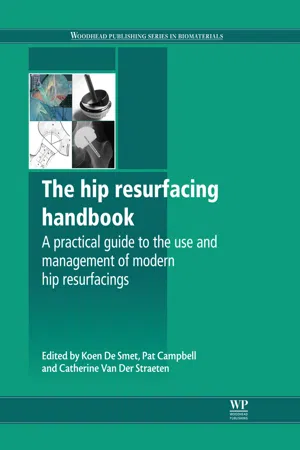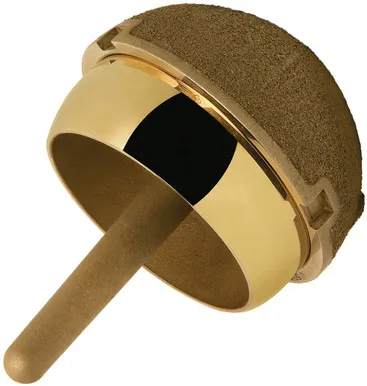
The Hip Resurfacing Handbook
A Practical Guide to the Use and Management of Modern Hip Resurfacings
- 576 pages
- English
- ePUB (mobile friendly)
- Available on iOS & Android
The Hip Resurfacing Handbook
A Practical Guide to the Use and Management of Modern Hip Resurfacings
About This Book
Hip resurfacing arthroplasty (HRA) using metal-on-metal bearings is an established but specialised technique in joint surgery. Based on the experience of leading experts in the field, The hip resurfacing handbook provides a comprehensive reference for all aspects of this important procedure.The first part of the book reviews and compares all the major hip resurfacing prostheses, their key design features, relevant surgical techniques and clinical results. Part two discusses clinical follow-up of the hip resurfacing patient, including pre- and post-operative examination, acoustic phenomena and rehabilitation. It also covers the use of techniques such as radiography and metal ion measurement, as well as bone scans, ultrasound, CT, MRI, PET and DEXA, to evaluate hip resurfacings. Part three reviews best practice in surgical technique, including the modified posterior and anterior approaches, as well as instrumentation, anaesthesia and revision surgery. Based on extensive retrieval studies, Part four includes examples of the main failure modes in HRA. The final part of the book includes patients' own experiences, a comparison of HRA with total hip arthroplasty (THA), regulatory issues and relevant web sites.Comprehensive in its scope and authoritative in its coverage, The hip resurfacing handbook is a standard work for orthopaedic surgeons and all those involved in HRA.
- A standard work for orthopaedic surgeons and all those involved in HRA
- Reviews and compares all the major hip resurfacing prostheses, their key design features, relevant surgical techniques and clinical results
- Clinical follow-up of the patient is discussed
Frequently asked questions
Information
The advanced ceramic coated implant systems (ACCIS) hip resurfacing prosthesis
Abstract:
1.1 Introduction

1.2 Information about the Advanced Ceramic Coated Implant Systems (ACCIS) Prostheses
Table of contents
- Cover image
- Title page
- Table of Contents
- Copyright
- Dedication
- Contributor contact details
- Woodhead Publishing Series in Biomaterials
- Acknowledgements
- Preface
- Introduction
- Part I: Hip resurfacing designs
- Part II: Clinical follow-up
- Part III: Operating techniques
- Part IV: Failure modes in hip resurfacing
- Part V: General hip resurfacing issues
- Index